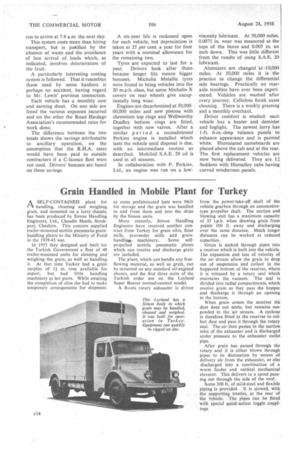Grain Handled in Mobile Plant for Turkey
Page 52

If you've noticed an error in this article please click here to report it so we can fix it.
A SELF-CONTAINED plant for tA handling, cleaning and weighing grain, and mounted on a lorry chassis, has been produced by Simon Handling Engineers, Ltd., Cheadle Heath, Stockport, Cheshire. This concern supplied trailer-mounted mobile pneumatic grainhandling plants to the Ministry of Food in the 1939-45 war.
In 1953 they designed and built for the Turkish Government a fleet of 48 trailer-mounted units for cleaning and weighing the grain, as well as handling it. At that time Turkey had a grain surplus of If m. tons available for export, but had little handling machinery at her ports. While awaiting the completion of silos she had to make temporary arrangements for shipment so some prefabricated huts were bbilt for storage and the grain was handled to and from them and into the ships by the Simon units.
More recently, Simon Handling Engineers have received another contract from Turkey for grain silos, flour provender mills and grainhandlins— machinery.. Some selfpropelled mobile pneumatic plants which can receive and discharge grain are included. - The plant, which can handle any freeflowing material, as well as grain, can be mounted on any standard oil-engined chassis, and the first three units of the Turkish order are on the Leyland Super Beaver normal-control model.
A Roots rotary exhauster is driven
from the power-take-off shaft of the vehicle gearbox through an automotivetype propeller shaft. The suction and blowing unit has a maximum capacity of 35 t.p.h. when drawing grain from points 100 ft. away and discharging over the same distance. Much longer distances can be worked at reduced capacities.
Grain is sucked through pipes into a receiver which is built into the vehicle. The expansion and loss of velocity of the air stream allow the grain to drop out of suspension and collect in the hoppered bottom of the receiver, where it is released by a rotary seal which maintains the vacuum. The seal is divided into radial compartments, which receive grain as they pass the hoppet and discharge it through an opening in the bottom.
When grain enters the receiver the dust does not settle, but remains suspended in the air stream. A cyclone is therefore fitted in the receiver to collect dust and pass it through the rotary seal. The air then passes to the suction inlet of the exhauster and is discharged under pressure to the exhauster outlet Pipe.
After grain has passed through the rotary seal it is either blown through pipes to its destination by means of delivery air from the exhauster, or else discharged into a combination of a worm feeder and vertical mechanical elevator. This delivers to a spout passing out through the side of the roof.
Some 200 ft. of mild-steel and flexible piping is provided. It is stowed, with the supporting trestles, at the rear of the vehicle. The pipes can be fitted with special quick-action toggle couplings.












































































































